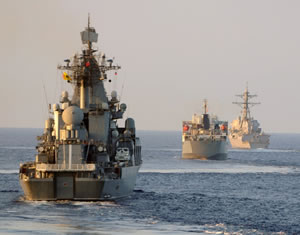Much as they did in April of this year, the United States Navy and the Japanese Self-Defense Force (SDF) have deployed missile batteries and Aegis-equipped warships in advance of North Korea’s next rocket launch scheduled for some time between 10 and 22 December.
Two Aegis-equipped Arleigh Burke-class destroyers, the USS Benfold and USS Fitzgerald, have been deployed to the region to track the North Korean rocket and to serve as a ballistic-missile defense force should such a defense prove necessary to protect property and life.
Several news outlets are reporting that the US Navy has also deployed its Sea-Based X-Band Radar (SBX-1) seaborne radar platform to monitor the North’s launch. The SBX-1 is the US Navy’s most advanced early-warning radar system capable of detecting, identifying, and classifying airborne threats from hundreds of miles away. Mounted on a fifth-generation oil-drilling rig of Norwegian design and Russian construction, the SBX-1 is self-propelled and is designed to operate in rough seas.
The X-band radar, likely the most sophisticated phased-array radar in the world today, sits atop a floating rig that measures 280 feet from the top of the radar dome to the rig’s keel and displaces some 50,000 tons. The rig is manned by a crew of approximately 86 personnel, most of them civilian technicians. The SBX-1 was deployed in 2009 and again in April 2012 to monitor the North’s most recent rocket launches.
US Department of Defense (DoD) officials have indicated that additional naval assets may be deployed to the region as appropriate.
The Japanese Maritime Self-Defense Force (JMSDF) also deployed three Aegis destroyers to the East China Sea and the Sea of Japan in preparation of the North’s rocket launch. The JDS Kongo, JDS Myoko, and JDS Chokai departed the southern JMSDF naval base at Sasebo, Nagasaki Prefecture on 6 December.
The three destroyers are equipped with RIM-161 Standard Missile-3 (SM-3) interceptors, a short- to intermediate-range missile that is part of the Aegis Ballistic Missile System. Japan has also deployed Patriot Advanced Capability-3 (PAC-3) missile batteries in the Okinawan islands of Miyako and Ishigaki located in the East China Sea, on the principal island of Okinawa, and near Japan’s Ministry of Defense’s headquarters in Tokyo.
Japanese Prime Minister Yoshihiko Noda and Defense Minister Satoshi Morimoto, following high-level cabinet meetings, issued an advance order to shoot down the rocket or any debris to protect Japanese property and life on 6 December. A similar order was issued in April 2012 when Pyongyang last attempted a rocket launch.
The Aegis destroyers are tasked with tracking and monitoring the rocket and may be authorized to fire their SM-3 missiles on the rocket should it appear to represent a danger to Japanese territory. They are being positioned in strategic locations where they will have the best chance of bringing down the rocket while it is still outside the Earth’s atmosphere.
Unconfirmed reports indicate that Prime Minister Noda prefers to rely on the PAC-3 batteries to bring down the rocket as it reenters Earth’s atmosphere if necessary. This may be an attempt to avoid antagonizing Pyongyang anymore than necessary.
Although Pyongyang continues to insist that its rocket launches should be of no concern to the international community since they represent the North’s sovereign right to engage in peaceful space exploration. Pyongyang is adamant in the claim that this launch, like the four previous failed launches between 1998 and 2012, is only another attempt to place a satellite into Earth orbit.
The United States and her Pacific allies have been vocal in expressing their belief that these launches are, in reality, ballistic-missile tests in violation of UN Security Council resolutions enacted in 2006 and 2009 banning North Korean ballistic missile tests.
South Korea’s Yonhap News Agency is reporting that Pyongyang has already assembled all three sections of the three-stage rocket on the Sohae launch pad and has started filling fuel storage tanks at the site in preparation for the final fueling of the rocket.
Satellite imagery is showing a significant snow cover around the launch site and appear to indicate that preparatory activities have been slowed by the weather. The latest imagery failed to discern any tracks in the snow indicating that preparations have likely been temporarily halted due to the adverse weather conditions. Japanese analysts are speculating that the launch will take place on 17 December in honor of the one-year anniversary of Kim Jong-un’s death.
South Korea, Japan, and the United States have already announced their intentions to petition the UN Security Council for additional, more stringent sanctions against Pyongyang if the launch goes ahead as scheduled. Of course, such sanctions would require Chinese and Russian concurrence before they could be imposed. What further sanctions that might gain Chinese and Russian approval are unknown.

















